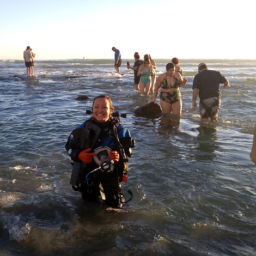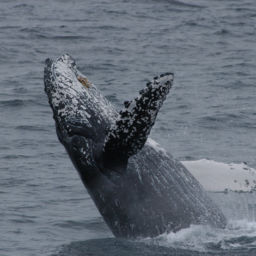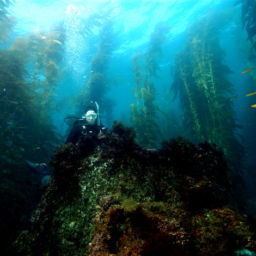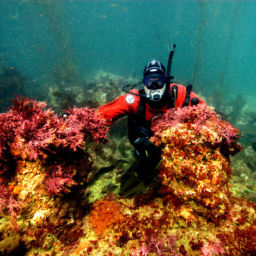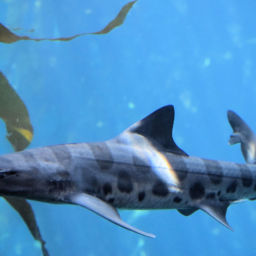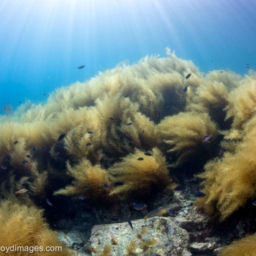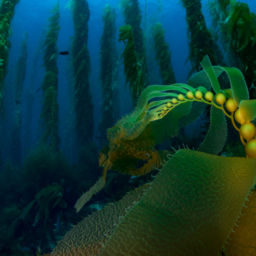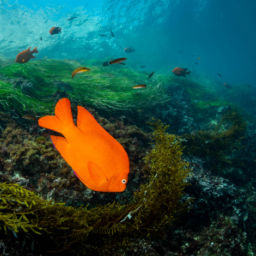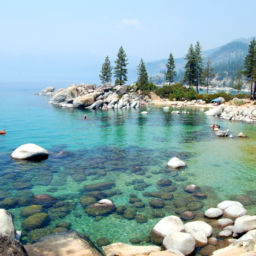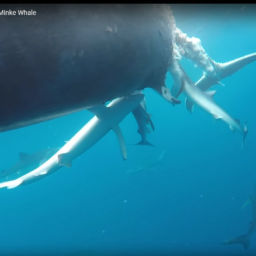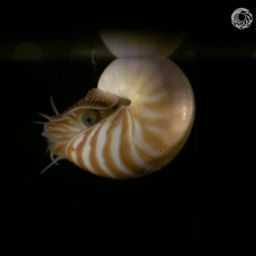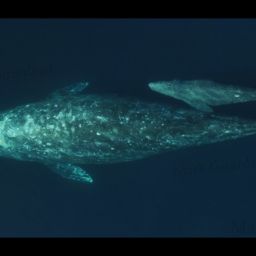Sandy beaches, year-round sunshine, not a hint of humidity in the air, and sharks. You read that right — one of the lesser-known advantages of diving Southern California is its year-round shark population. The area is home to more than 10 different species of shark, and, for many divers, there is no thrill greater than observing the ocean’s top predator in action. Here, we’ve compiled a list of the many species one could encounter while searching for Southern California sharks. However, it’s quite rare to encounter many of these species and it can take hundreds of dives in their respective habitats before ever seeing some of the most elusive species.
Sharks in general are quite skittish, and the sight and sound of a diver’s bubbles, along with our sheer size, tends to keep them at a distance. For divers, this means most shark interactions consist of fleeting moments.
Most Southern California sharks mature slowly and give birth to a few young at a time, meaning population decline can have a drastic impact on species survival. Due to the expansive worldwide distribution of many shark species, there is much uncertainty regarding species status. The lack of data surrounding these animals makes assessing their vulnerability to certain pressures difficult. We know sharks are vulnerable to certain human-related pressures, such as overfishing, coastal development and runoff pollution, along with other environmental factors. International organizations such as the Convention on International Trade and Endangered Species (CITES) are working to increase protections for exploited shark populations worldwide, and these protections have been expanding quickly over the last half-decade.
Locally, there are some 50 Marine Protected Areas (MPAs) providing refuge for nearly 15 percent of Southern California’s waters. These further help protect the diversity and habitat of not just sharks, but all marine wildlife.
When interacting with and observing sharks in their natural habitat, we begin to perceive the true nature of these apex predators, and how different that reality can be from perception. Sharks play a critical role in ocean ecosystems and are not the human-eating machines portrayed in the media. Here then are a few shark species you may find on a dive in Southern California.
Sevengill shark Notorynchus cepedianus
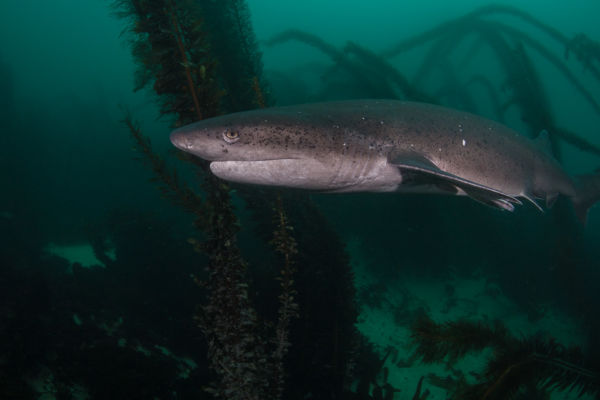 This coastal shark is distributed widely but divers only see it regularly in a few locations worldwide. One of these locations is right here in Southern California, at famed marine reserve La Jolla Cove. You’ll generally find sevengills roaming through kelp forests or rocky reefs, close to the sea floor. The easiest way to identify this shark is by its blunt snout and single posterior dorsal. It also has — you guessed it — seven gills. Encounters may be brief, so make sure your camera is ready.
This coastal shark is distributed widely but divers only see it regularly in a few locations worldwide. One of these locations is right here in Southern California, at famed marine reserve La Jolla Cove. You’ll generally find sevengills roaming through kelp forests or rocky reefs, close to the sea floor. The easiest way to identify this shark is by its blunt snout and single posterior dorsal. It also has — you guessed it — seven gills. Encounters may be brief, so make sure your camera is ready.
School Shark Galeorhinus galeus
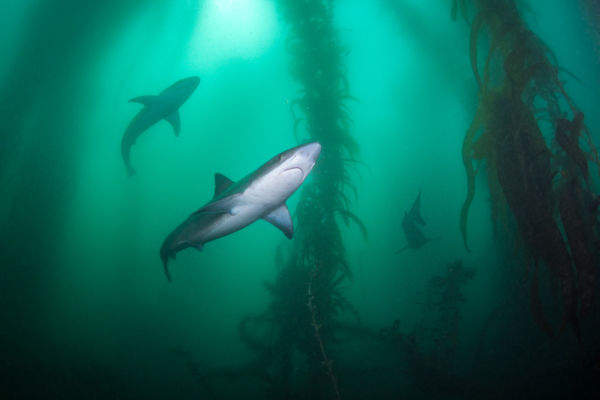 These 5- to 7-foot (1.5 to 2 m) sharks are long and slender, with a darkish-gray skin tone on top and a white underside. School sharks are coastal sharks that migrate to shallow kelp beds, forming aggregations during spring and summer. School sharks are very cautious around divers and will spook at any large exhalation or rapid movement.
These 5- to 7-foot (1.5 to 2 m) sharks are long and slender, with a darkish-gray skin tone on top and a white underside. School sharks are coastal sharks that migrate to shallow kelp beds, forming aggregations during spring and summer. School sharks are very cautious around divers and will spook at any large exhalation or rapid movement.
Horn Shark Heterodontus francisci
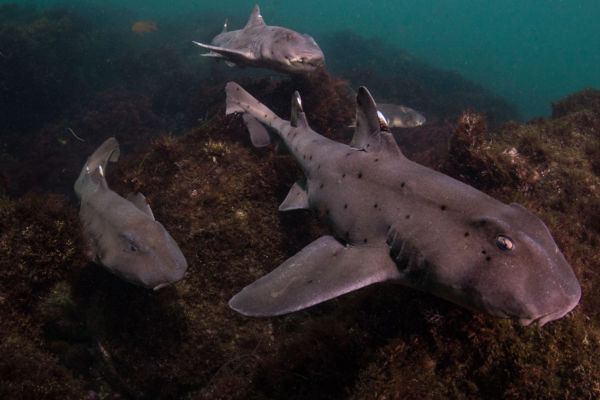 The horn shark is a small, spotted shark species with large white spines on its dorsal fins. This bottom dweller can become so camouflaged within rocky reefs and surf grass beds you can easily swim right over one without noticing. Known to be a sluggish fish, horn sharks have a very small home range, usually no larger than 10,000 sq ft. (1,000 m²).
The horn shark is a small, spotted shark species with large white spines on its dorsal fins. This bottom dweller can become so camouflaged within rocky reefs and surf grass beds you can easily swim right over one without noticing. Known to be a sluggish fish, horn sharks have a very small home range, usually no larger than 10,000 sq ft. (1,000 m²).
Pacific Angel Shark Squatina californica
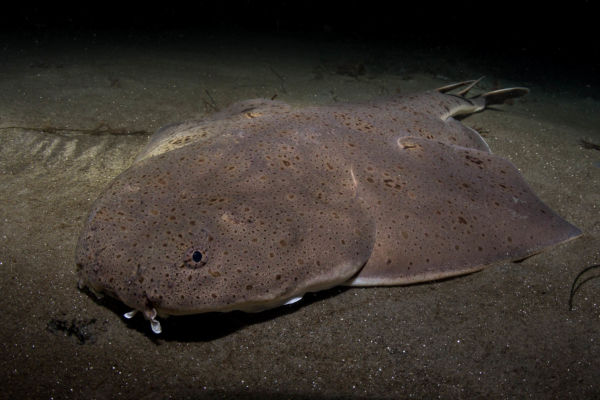 The Pacific angel shark has a flattened shape and enlarged pectoral and pelvic fins. An ambush predator, this shark is often seen with nothing but its eyes exposed above the sandy ocean floor. When exposed, divers can see its cryptic, spotted skin pattern. Pacific angel sharks tend to inhabit shallow, coastal regions near kelp forests and sandy flats.
The Pacific angel shark has a flattened shape and enlarged pectoral and pelvic fins. An ambush predator, this shark is often seen with nothing but its eyes exposed above the sandy ocean floor. When exposed, divers can see its cryptic, spotted skin pattern. Pacific angel sharks tend to inhabit shallow, coastal regions near kelp forests and sandy flats.
Great white shark Carcharodon carcharias
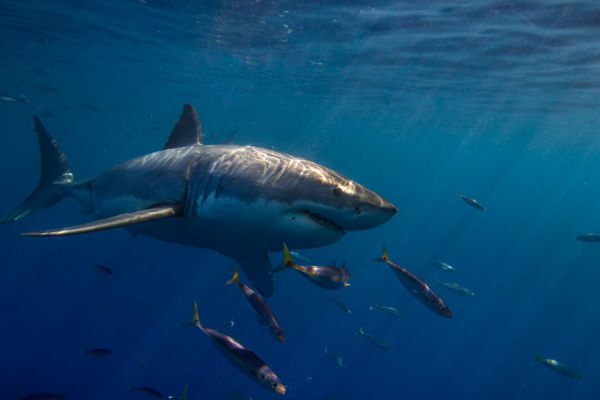 The great white shark is the ocean’s top apex predator and can reach over 20 feet (6m) in length and weigh over 2.5 tons. White sharks are migratory and cover large distances in the open ocean. Juveniles occasionally venture inshore, following food sources. Divers rarely encounter them, but they are most often seen at offshore seamounts and exposed dive sites along the California coast.
The great white shark is the ocean’s top apex predator and can reach over 20 feet (6m) in length and weigh over 2.5 tons. White sharks are migratory and cover large distances in the open ocean. Juveniles occasionally venture inshore, following food sources. Divers rarely encounter them, but they are most often seen at offshore seamounts and exposed dive sites along the California coast.
Leopard shark Triakis semifasciata
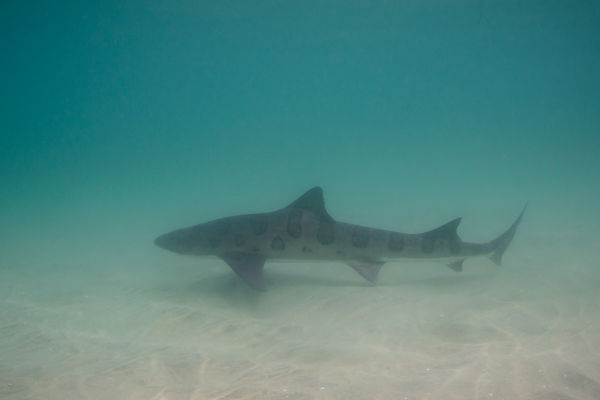 The leopard shark is a mid-sized coastal shark species with large, dark saddles and blotches covering its body. They aggregate in late summer, preferring sandy bays and estuaries in Southern California. It may be easier to observe this species while snorkeling, due to the extreme proximity to shore and shallow depths they inhabit.
The leopard shark is a mid-sized coastal shark species with large, dark saddles and blotches covering its body. They aggregate in late summer, preferring sandy bays and estuaries in Southern California. It may be easier to observe this species while snorkeling, due to the extreme proximity to shore and shallow depths they inhabit.
Not pictured, but in the area:
Shortfin Mako Shark Isurus oxyrinchus
Makos are large, predatory sharks that inhabit the open ocean. Divers usually encounter them in high-energy, openw-ater interactions conducted offshore. These sharks’ speed and agility allows them to cover great distances in search of prey or mates — they can hit speed bursts over 45 miles per hour (72 km/h).
Blue Shark Prionace glauca
The blue shark is a sleek, torpedo-shaped shark living in the open ocean. One of the most photogenic of Southern California sharks, the dorsal side of the blue shark shines an exquisite shade of indigo blue. A highly migratory species, blue sharks will travel across ocean basins several times in their lifetime.
Swell Shark Cephaloscyllium ventriosum
A small, bottom-dwelling shark, the swell shark only reaches 3 feet (0.9 m) in length. White spots and blotches cover the swell shark’s yellow-brown body, helping it blend into its rocky reef habitat. When threatened or preyed upon, this shark will contort its body into a U-shape and swallow large quantities of seawater, making it difficult to bite.
Gray smooth-hound shark Mustelus californicus
Smooth-hound sharks are small, slender animals with large oval eyes and a brownish-gray topside, fading to a light underbelly. You can sometimes find them in shallow, coastal waters schooling with leopard sharks. Smooth-hound sharks prey upon crustaceans and occasionally cephalopods and bony fishes, which means divers usually spot them close to the seafloor.
Common thresher shark Alopias vulpinus
This large open-ocean shark has a streamlined body, short, pointed snout and is metallic purple and brown in color. Threshers have an impressive tail — for which they’re named — measuring half of the body length. Sharks use it like a whip to deliver incapacitating blows to their prey. Due to its widely migratory behavior and cautious nature, divers rarely see this species in the wild.


